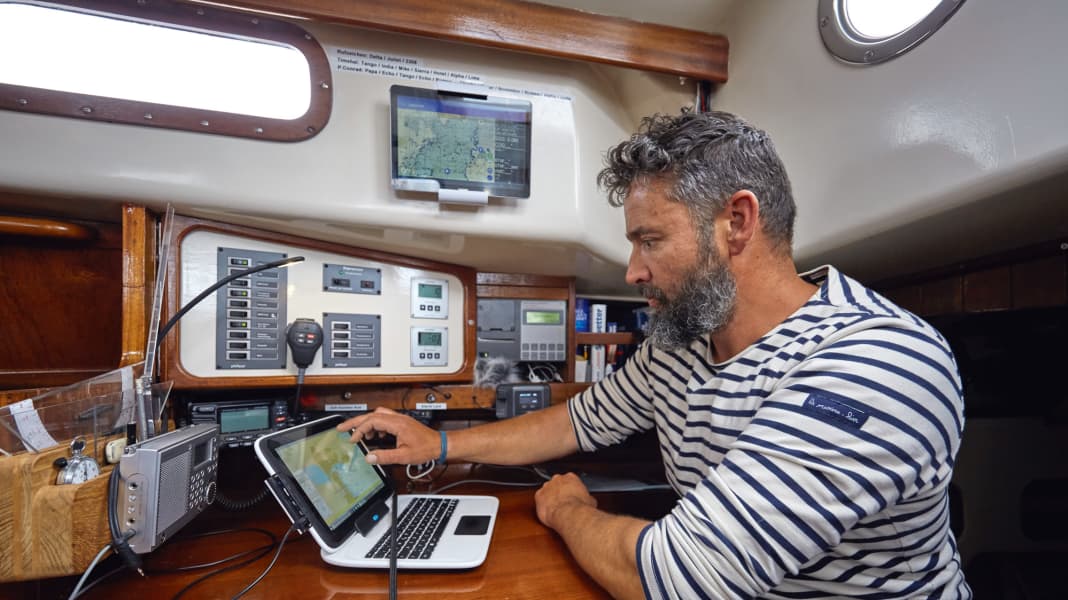
In this article:
Log on to the Wi-Fi in the harbour just like at home and surf without data limits? Wireless Internet is part of the service in many marinas. However, coverage and bandwidth are rarely optimal, so whether the Internet connection is stable and provides usable transmission speeds depends heavily on the berth.
Option 1: Strengthen harbour WiFi
Below deck in particular, not even the weather app forecast loads smoothly, let alone videos or chart updates. The problem here is the frequencies. Wi-Fi operates at 2.4 and 5.8 gigahertz. In this range, radio waves behave almost like light and are shadowed by obstacles. This is also familiar from the router at home. Sometimes, even in larger homes, several networked transmitting stations are needed to cover all rooms. An optimum connection can only be achieved if the transmitting and receiving antennas have visual contact. In harbours, a forest of masts is enough to block the radio signal. The solution for more range is therefore practically obvious: the antenna must be moved out of the radio shadow of the boats. To call up the weather report or receive and send e-mails, it is sometimes enough to climb into the cockpit.
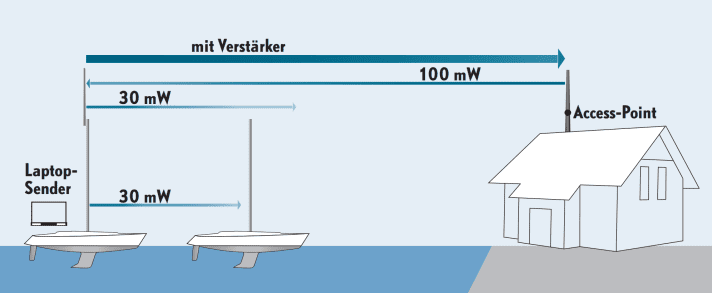
If the signal remains weak, only additional hardware in the form of an external antenna can help. Laptop and smartphone antennas must work in all directions so that contact is not lost during movement. The fixed external antenna, on the other hand, can bundle the signal in the horizontal plane: even with the same power, this results in a significantly greater range. It also has a better view of the harbour hotspot. The land-based network generally transmits with more power and is heard by the mobile device further than it can transmit. If it has an amplifier, the external antenna also solves this problem.
As this cannot be retrofitted to a smartphone, notebook or chart plotter, a variant with its own hotspot is chosen. This means that the aerial is connected to a router, which in turn generates its own on-board Wi-Fi. This requires an aerial with a radio modem and the appropriate router. Depending on the model, the connection between the antenna in the masthead and the router in the boat is either via USB cable or Ethernet.
USB solutions are available from as little as 180 euros. Problems arise if there are more than five metres between the antenna and the router, in which case active USB extensions are required. These difficulties do not arise with an antenna with an Ethernet connection. Such network cables allow lengths of up to 100 metres, but more effort is required for the power supply. The most common solution is a switch that feeds power into the network cable via Power Over Ethernet (POE). It is best to buy such a system as a package from a provider that you can also contact if you have any questions about configuration, as this is not entirely trivial.
More range for W-Lan
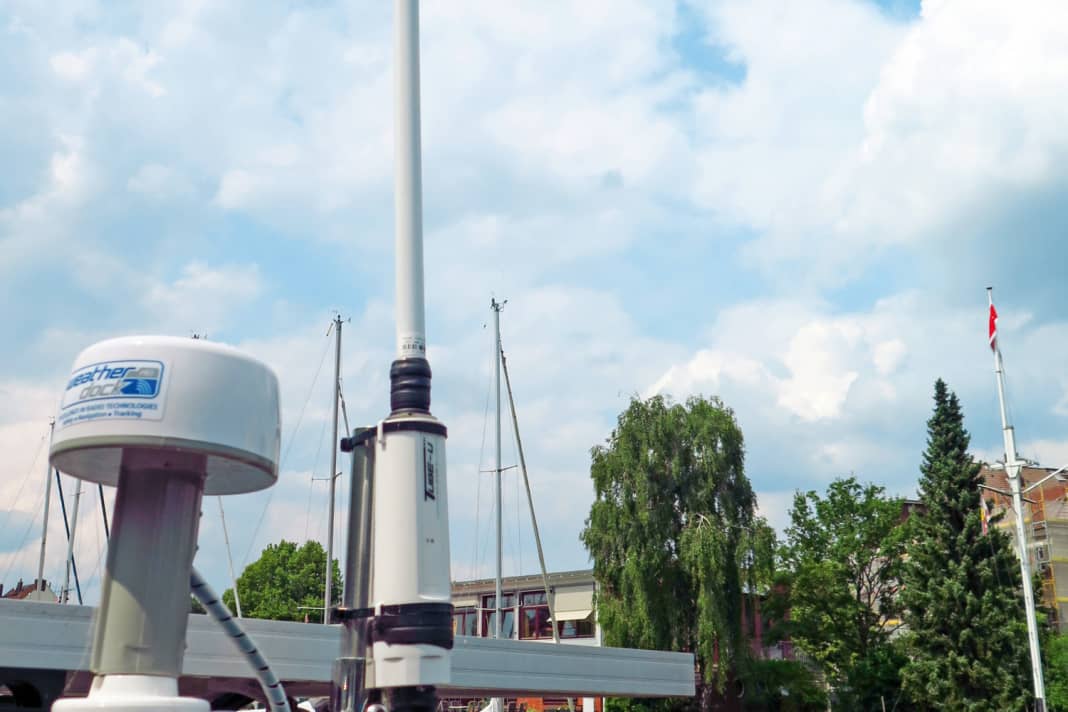


Option 2: Access the network via LTE or 5G
If you need a reliable network for working, the harbour Wi-Fi is rarely a good choice. Even if the connection is stable, the bandwidth is barely sufficient for smooth video conferencing because you are sharing the connection with too many users.
Thanks to well-developed LTE and, in some cases, 5G networks, a mobile phone connection is faster and more stable than the marina service in many coastal areas. At least if you have an appropriate contract or the right local prepaid card. Because even if the annoying roaming costs in the EU are history, an international card can still be worthwhile. Especially when it comes to data usage, there are sometimes much cheaper tariffs. For Denmark, for example, from Lebara or from Telia and Telenor in Sweden. Internet comparison portals can help you find the best provider for your planned trip.
To connect more than one device to the network via the data card, the hotspot function of the smartphone or tablet is basically sufficient. If you want a more convenient solution, you can use a mobile router. Models such as the DWR 932 from D-Link for the LTE network are available from 40 euros. It becomes significantly more expensive when 5G support is required. In this case, the Nighthawk M5 from Netgear, for example, comes into question for around 900 euros.
Thanks to the integrated rechargeable battery and USB charging function, the routers can easily be powered from the on-board power supply. However, they do not offer a greater range per se than a tablet or smartphone. As with harbour Wi-Fi, this would require an external antenna in an elevated position. This is provided for in very few models. And it is also not easy to implement, as the length of the antenna cable is a problem with the frequencies used in mobile communications. With standard cables, there is a loss of three decibels over ten metres. This means that only half the signal strength reaches the router. The advantages of the external aerial are therefore cancelled out by the cable. The problem can be reduced by using higher quality cables, but long cables remain problematic.
The Webboat 4G from Glomex offers a solution. The router and antennae are in a weatherproof housing and are mounted on the mast. This solves the damping problems, but you need a power supply in the top of the boat and have to take to the water to change the SIM card. "We only recommend something like this for motorboats," says Niko Reisch from Glomex importer Nordwestfunk.
The best option: separate router and antenna
He advises everyone else to use separate systems consisting of a built-in router and antennas. Such yacht routers already have more range than a telephone with the enclosed antennas. With high-quality external antennas and appropriate cables, reception can be significantly improved. The manufacturers promise up to 30 nautical miles from the nearest radio mast. This equates to complete coverage for most trips on the North Sea and Baltic Sea.
To minimise attenuation in the cable, the antennas should be mounted at saling height at most, says Reisch. Appropriate packages consisting of routers and antennas are available from Glomex, but also from Locomarine, Scout, Digital Yacht, Raymarine, GMM and various other providers.
The basic functions, i.e. receiving the mobile network and creating a Wi-Fi hotspot, are generally similar. However, the maximum data transfer rates, configuration options and additional functions vary depending on the manufacturer and model. Some systems offer monitoring options such as anchor and theft alarms, which send the ship's position to the mobile phone, or integration into the boat's own NMEA 2000 network, including switching functions.
Devices with two slots for SIM cards can usually bundle both connections and thus provide higher transfer rates or use different cards for two countries. The cheapest complete solutions with LTE support, such as the 4G onBoard set from Scout, start at around 530 euros. Those who enjoy DIY and configuration can use industrial routers such as the Teltonika RUT241. These or similar models are usually also found in the housings of yacht systems. Depending on the source of supply, the Teltonika LTE router costs around 160 euros. Of course, weatherproof outdoor antennas are also required for maximum range.
Selected mobile routers and systems for installation






Important: the LTE category of the router
Most devices offered for yachts fall into LTE category four, abbreviated to Cat 4, which means they can transmit a maximum of 150 megabits per second (Mbps). Even if the network and the tariff would allow more, it is not possible to surf faster. More sophisticated models fall into category six, which corresponds to a maximum transfer rate of 300 megabits per second. By comparison, current smartphones can handle category 16 or higher, which means they can transfer one gigabit per second. However, this is a theoretical value. Currently, even well-developed LTE networks only manage 300 to 500 megabits per second.
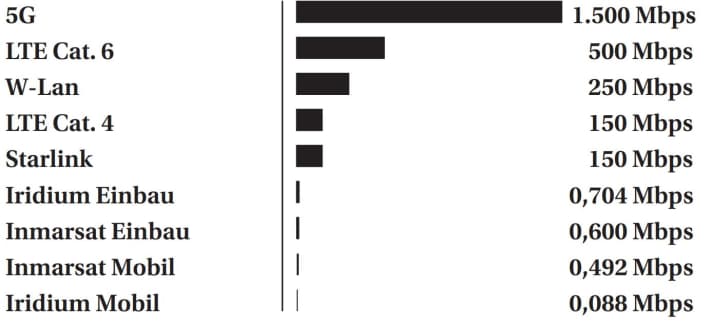
In remote coastal areas, the frequency band used becomes a brake. As with all radio systems, the frequency has an influence on the range and maximum data transmission. The higher the frequency, the faster the data can be transmitted, but the shorter the range. Low frequencies are therefore used in rural areas that need to be covered by as few radio masts as possible.
In the case of LTE, this is 800 megahertz. This allows a radius of around ten kilometres to be covered per radio mast. But only with a maximum transmission rate of 50 megabits per second. It is precisely this area coverage that promises the greatest range at sea and can also be fully utilised with a category four router.
Data consumption per hour on demand
A few examples to illustrate this: downloading the five-day wind forecast from the Swedish Meteorological Service requires around 28 megabytes. At 50 megabits per second, it takes around four seconds to download the entire forecast. YouTube videos in HD resolution run at around 10 megabits per second without loading pauses. Zoom recommends a transfer rate of at least 3.8 megabits per second for HD conferences.
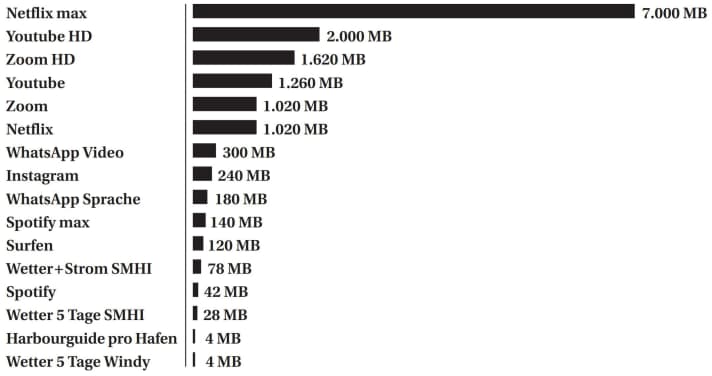
Devices for 5G do not automatically provide more speed or greater range
When it comes to smartphones, it is clear that a new device should be capable of the latest 5G wireless standard. When it comes to choosing a mobile router for on-board use, the answer is far less clear. This is because 5G devices are significantly more expensive, but do not necessarily offer higher data throughput compared to LTE.
In order to achieve good coverage, network operators in many places use the former UMTS frequencies of 2.1 gigahertz or the LTE network. This enables a maximum of 225 megabits per second, which is about as much as well-developed LTE networks can achieve. In practice, however, values between 60 and 140 megabits are the order of the day.
A really big increase in speed is only possible in the 3.6 gigahertz network. Transmission rates of 1,500 megabits per second are then theoretically achievable. However, this infrastructure is by no means available everywhere outside the metropolises. The high-frequency network requires a much denser network of radio masts due to the shorter range.
Mobile phone ranges with 5G and LTE



For maximum range, 5G can also operate on 700 megahertz, the so-called low band. As with LTE, this improves coverage. In purely technical terms, the 5G network should then be able to achieve at least up to 200 megabits per second. That would be five times as fast as with LTE coverage. There is no general answer as to how much of this will remain in practice, as it also depends on how well the radio masts themselves are networked.
According to studies by Open Signal, the average data rate of LTE is around 46 megabits, while 5G users achieve around 140 megabits. However, it is not clear to what extent these statistics based on user data can also be applied to the performance of the network off the coast and at sea. This is because there are very few users there compared to on land and the database is correspondingly thin.
Anyone sailing near the coast in urban areas, for example on the Øresund, will be able to surf much faster with a 5G router than with LTE. In remote anchorages, the speed advantage is likely to be lower or not noticeable.

